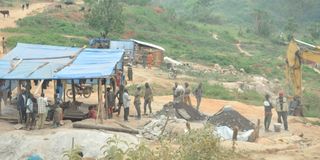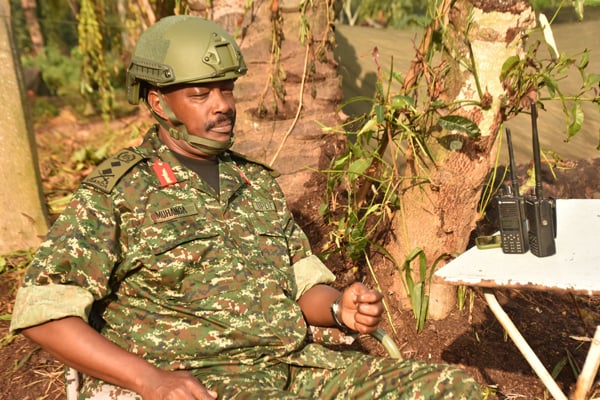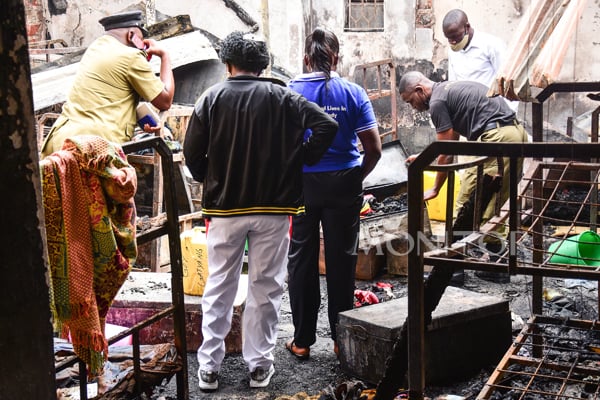Prime
Mercury cartels thrive across Uganda’s gold mines

Artisanal gold miners at Kisiita mining site Kassanda District go about their business on March 18, 2020.photo/file
What you need to know:
Many gold miners use mercury during mining, however, experts warn that the use of the metal has far greater consequences on the health of the public as well as the environment.
Sofia, a shabby border outpost in Busia District, is the commercial pulse in this area.
Beyond symbolism, the border is an artificial colonial relic that attempts to separate a community, which shares the same ethnicity, culture and dialect.
At Sofia, security personnel can barely control locals who stream across this porous spot.
It is also a haven for smuggling as communities bring in cheaper commodities. However, there is barely much scrutiny and security personnel are often part of these cartels and are complicit resulting into dangerous items slipping into the country. Among them mercury used across gold mines in Uganda.
Artisanal (small-scale) miners use it for high rates of gold recovery as it is a quicker method to recover gold out of the ore as it picks the nuggets in the dust like a magnet.
However, when mercury vapour is inhaled, it can affect the central nervous system and, depending on exposure levels, can impair cognition and in some cases cause death.
Studies show that even low exposure levels are known to cause toxicities to the cardiovascular, reproductive, developmental, renal, and central nervous systems.
“Any part of the body can be poisoned - the brain, the nervous system, the liver, the kidneys. It is heavy metal and this metal is in liquid form,” Dr Vincent Karuhanga told Daily Monitor.
Mercury is also harmful if absorbed through cuts and abrasions of the skin.
“So, it can easily be absorbed by the skin and if one touches it, he can easily get poisoned. It is a very dangerous metal, people have got poisoning to the kidneys causing them to fail, people have had injuries to the brain, sleeping all the time, burning sensation, so one has to be very careful. Every year, one has to examine how much mercury is in their body so that it is not at poisonous levels,” Dr Karuhanga says.
Of even more concern is the toxicity produced when mercury is emitted into the environment.
It can accumulate in lakes, rivers, streams, and ocean. There, anaerobic organisms digest and transform it into methyl mercury, a more toxic form of mercury, which accumulates and becomes concentrated up the food chain in plankton, fish, birds and mammals.
To halt this threat, the Minamata Convention on Mercury in October 2013 was adopted, which spells out targets to phase out the manufacture, export or import of a number of mercury-added products specified in the convention.
Uganda is a signatory to the Minamata Convention and has already developed legal frameworks to facilitate the phase-out of mercury.
But beyond laws and policies that have been tucked away on shelves, mercury use continues to thrive.
“Government needs to put a strong policy in place. It is not enough to say Uganda has assented to the Minamata Convention,” Josephine Aguta, a gold miner in Busia, says.
At Sofia, the cartels dealing in mercury ensure that there are enough supplies coming from Kenya to be able to sustain gold miners that rely on it.
To be able to monitor the trade in this illicit product, we traversed parts of Busia to find mercury dealers.
Tira Town Council, which lies at the parallels of the Uganda and Kenya border, is a commercial hub that has sprouted on the fortunes of gold.
It is easy to buy grammes of gold in this area. It is also prominent for the sale of mercury, which is a lucrative commodity.
“How mercury enters is through smuggling and being a business you can walk over here. The checkpoints are not very strict. Mercury is very easily accessible,” Aguta says.
Many of those involved in the mercury trade are also gold dealers as both are interdependent commodities.
To expose those involved in this illegal trade, we carried out an undercover investigation.
We were able to purchase mercury, which is sold discreetly. It is quite costly. A kilogramme can cost as much as Shs800,000.
It is then sold to largely small-scale miners though a few large-scale miners use it as well.

Most gold miners in Uganda do not wear personal protective gear when carrying out their work. photo/file
In Tira, young men rely on rudimentary means and use mercury for amalgam smelting.
During this process, mercury is mixed with gold-containing materials, forming a mercury-gold amalgam, which is then heated to obtain the gold from sediments and rocks.
The miners don’t have personal protective gear. There is a danger of directly inhaling the vapours of this liquid.
In Karamoja Sub-region, a spike in insecurity has resulted in the taking over of large swathes of gold mining fields in Moroto, Kotido, and Kabong by ruthless cattle-rustlers.
“In Nakabat, I think we have mineral mafias [warriors], who have taken over an entire gold mine and police is not there, the army is not there. Those who attempted to go in, we got reports that they were shot at. There is need for government to strengthen security in Karamoja,” Andrew Byaruhanga, the executive director, of Resource Rights Africa, an extractives sector watchdog organisation based in Karamoja, told Daily Monitor.
However, in Amudat District, the area is relatively peaceful.
Here, there is widespread use of mercury. In Chepkarat Parish in Karita Sub-county, Amudat District, women use mercury to pan and sieve tiny particles of gold.
“We have been working on the extractives sector in Karamoja. The use of mercury in gold panning is one of those dangerous chemicals being used to amalgamate gold in the mines. We have realised that people are using their bare hands to touch gold. The water, which has been contaminated with mercury, is causing a negative impact on their health,” Byaruhanga says.
“We have also seen that the waste water after gold panning is poured into the streams and it is the same water that is being used by animals and for domestic use,” he adds.
These streams feed rivers that snake through Karamoja and Teso sub-regions leaving a footprint of contamination.
“Karamoja is the catchment area for all the water that comes to Teso Sub-region and of course serves up to Lake Kyoga. If this is not mitigated then we are headed for disaster, but also the meat that we are consuming in Karamoja; the cows, the sheep, the goats are taking water from these streams contaminated by mercury, then we are not safe,” Byaruhanga says.
As soon as we arrived at a gold pit in Karita Sub-county, we discovered a vehicle, which is said to have just smuggled jerry-cans of mercury. The mercury was then hidden in homes at this site.
Women, who are working here where bowels of the earth are dug, are exposed to mercury, which poses greater harm to them.
Studies show that very high doses of total mercury in pregnancy have a harmful effect on the development of offspring, with increased risks of cerebral palsy and cognitive impairment.
“We have seen that women who are panning gold using mercury do it without any protective gear,” Byaruhanga says.
A number of studies show that miners in Mubende, Busia, Karamoja, and Buhweju, among others, rely on mercury to extract gold.
Some of the symptoms that were unraveled among artisanal miners as a result of mercury use include shaking of hands, eye-related difficulties, numbness, back pain, fatigue, stress headache, dizziness, joint pain, and respiratory problems.
“We have been working with government agencies notably Nema. Scientists have informed us that the samples that they took to South Africa - hair and the fur from animals - all tested positive for high concentration of mercury and this is worrisome,” Byaruhanga says.
Miners, especially those in Mubende, Busia, and Ibanda had mercury in their blood and urine.
“We carried out a study in five mining districts and our findings show that mercury levels in the blood were higher than those recommended. We also carried out tests on crops, fish, animals, and soil. The results reflected high levels of mercury,” Geoffrey Kameese of Uganda National Association of Community Health (UNACOH), says.
The dangers of mercury are insidious and can place human, animal, and aquatic life at peril, damage the environment and pollute water sources.
“The effects of mercury use are felt after a long time. If its effects were immediate, people would have probably left it. But because its effects tend to occur over a long period, people hardly realise the problems but I have seen people in Mubende lose nails,” Charles Dhizala, a gold miner, says.
“When you look at the effect of mercury, they are very slow, it has made people doubt that mercury could be dangerous. It is to a small extent that people have understood the dangers of mercury, you will find some people who will tell you that my eyes cannot see very well, my ears are not well,” Aguta says.
However, as long as the mining industry remains unregulated, rudimentary, mercury will remain in use across gold mines.
“There is need to promulgate the Mining and Minerals Bill 2021. It looks at formalising the artisanal and small-scale miners, there is no proper regulation. This is coming in to formalise the artisanal and small-scale miners such that government can know the number of gold miners in a particular location so that one can be held accountable for using mercury,” Byaruhanga says.
There are also safer methods that have been implemented in Busia and other parts of the country.
The borax method is one such technique which uses borax as a flux to purify gold concentrates.
“The gold buyers now wear masks. When it comes to melting of gold, it is done safely in pits to mitigate the effects of mercury. In the past, we would sluice in roads and streams. People would burn mercury even in eating places, but we are now teaching the community about the dangers of mercury,” Aguti revealed.
Government also needs to empower the Police Mineral Protection Unit to be able to monitor illegal activities in mines.
In March, government hired a South African-based company to carry out surveys and mapping of the mineral-rich Karamoja Sub-region to ensure effective exploration.
The project, which cost Shs86 billion, was awarded to Xcaliber Airborne Geophysics.
The project, will offer detailed infrastructure and geotechnical studies, geohydrology mineral, oil and gas exploration projects to large mapping surveys for grass-roots exploration and investor information. When the survey is completed in 12-months, watchdog organisations in the extractives sector believe that it will largely anchor mining in Karamoja, which is quite opaque and unregulated.
About the Minamata Convention on Mercury
The Minamata Convention on Mercury is a multilateral environmental agreement that addresses specific human activities which are contributing to widespread mercury pollution.
The Minamata Convention requires that party nations:
•Reduce and where feasible eliminate the use and release of mercury from artisanal and small-scale gold mining (ASGM).
•Control mercury air emissions from coal-fired power plants, coal-fired industrial boilers, certain non-ferrous metals production operations, waste incineration and cement production.
•Phase-out or take measures to reduce mercury use in certain products such as batteries, switches, lights, cosmetics, pesticides and measuring devices, and create initiatives to reduce the use of mercury in dental amalgam.
•Phase out or reduce the use of mercury in manufacturing processes such as chlor-alkali production, vinyl chloride monomer production, and acetaldehyde production.
•In addition, the Convention addresses the supply and trade of mercury; safer storage and disposal, and strategies to address contaminated sites.
•The Convention includes provisions for technical assistance, information exchange, public awareness, and research and monitoring. It also requires Parties to report on measures taken to implement certain provisions. The Convention will be periodically evaluated to assess its effectiveness at meeting its objective of protecting human health and the environment from mercury pollution.
Source: Unites States Environment Protection Agency
What they say...
Vincent Karuhanga, healthcare practitioner
So, it can easily be absorbed by the skin and if one touches it, he can easily get poisoned. It is a very dangerous metal, people have got poisoning to the kidneys causing them to fail, and people have had injuries to the brain, sleeping all the time, burning sensation.
Josephine Aguta, gold miner
Government needs to put a strong policy in place. It is not enough to say Uganda has assented to the Minamata Convention. How mercury enters is through smuggling and being a business you can walk over here. The checkpoints are not very strict. Mercury is very easily accessible.
Andrew Byaruhanga, Human Rights activist
The use of mercury in gold panning is one of those dangerous chemicals being used to amalgamate gold in the mines. We have realised that people are using their bare hands to touch gold. The water has been contaminated with mercury, is causing a negative impact on their health.
Charles Dhizala, gold miner
The effects of mercury use are felt after a long time. If its effects were immediate, people would have probably left it. But because its effects tend to occur over a long period, people hardly realise the problems but I have seen people in Mubende lose nails.
Geoffrey Kameese, health advovcate
We carried out a study in five mining districts and our findings show that mercury levels in the blood were higher than those recommended. We also carried out tests on crops, fish, animals, and soil. The results reflected high levels of mercury.




